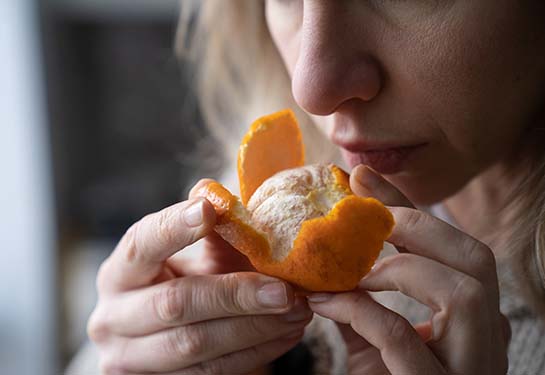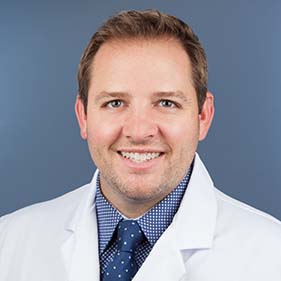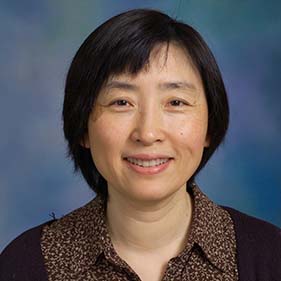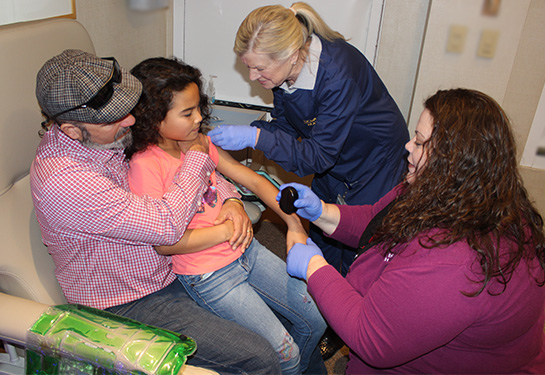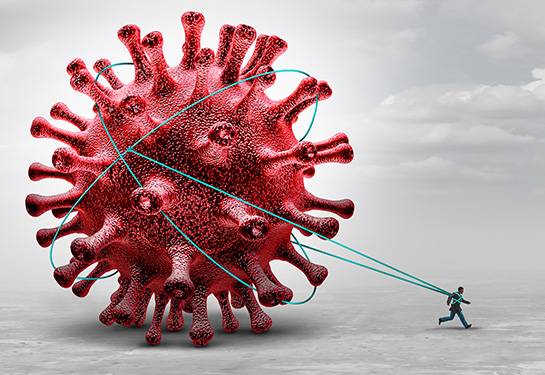UC Davis researchers dissect COVID-19’s impact on sense of smell
Otolaryngologist Toby Steele and molecular neuroscientist Qizhi Gong recently received a two-year, $275,000 National Institutes of Health grant to study how COVID-19 disrupts the sense of smell. In this unique collaboration, the UC Davis Health team hopes to potentially identify diagnostic tools and therapeutic treatments. They'll be characterizing the severity and length of patient smell loss, collecting samples and conducting in-depth protein analyses to dissect the mechanisms that cause olfactory dysfunction.
“We really don't understand how COVID is creating both acute and chronic smell loss,” said Steele, associate professor of Rhinology and Skull Base Surgery at UC Davis Health. “To figure that out, we’re going to study samples from COVID patients with acute olfactory loss and see if we can find a molecular fingerprint.”
Steele has been studying olfactory loss in patients for more than a year. He received earlier support from UC Davis’s COVID-19 Research Accelerator Fund, and one of his residents presented their work at a weekly Zoom meeting to disseminate COVID findings. Gong was in the meeting and saw a great opportunity to pool their expertise.
“I was super excited because my research is on olfaction using animal models,” said Gong, professor in the Department of Cell Biology and Human Anatomy. “I had been looking for a way to contribute to our understanding of COVID and olfaction.”
A recent study found there may be more than a million Americans with persistent olfactory loss from COVID. That’s a huge number of people who are dealing with this and are probably miserable.”—Toby Steele
The Costs of COVID
Around 80% of COVID patients experience some olfactory loss. Most recover in a few weeks, but some may never regain their sense of smell.
While loss of smell and taste are often considered mild symptoms, they are far from trivial. Patients describe a wide range of quality-of-life issues, from eating tasteless food to missing their partner’s cologne. People are more likely to be depressed, gain weight and even miss common danger signals we usually take for granted.
Dividing the Work
The partnership begins in Steele’s clinic, where he extracts nasal samples around olfactory cells, which are only found in small patches in the nasal cavity. These cells are relatively rare and difficult to sample, making them challenging to study. Steele’s rhinology expertise helps him pinpoint where to collect the appropriate samples.
In addition to getting samples, Steele’s group carefully characterizes each patient’s symptoms. Most studies ask patients to self-assess their smell loss, which can be imprecise. To get more objective data, Steele’s team uses a 40-item smell identification test, the scientific version of a scratch and sniff. With these results, they can determine whether a patient has mild, moderate or severe microsmia (reduced ability to smell) or full-on anosmia (complete loss of smell).
We want to identify the distinct protein fingerprints in COVID-19 olfactory mucosa,” said Gong. “We believe that will give us insights into the mechanisms that drive this dysfunction and perhaps help us predict recovery.”—Qizhi Gong
From there, Gong’s lab conducts a detailed proteomic analysis of the samples, looking at expression levels for 2,500 proteins. Ultimately, they hope to map the molecular signals that lead to olfactory loss.
While COVID does not target olfactory neurons, it does appear to hit sustentacular cells, which are support cells found around the neurons. Losing these cells might influence COVID-related olfactory loss. Inflammation from the body’s immune response may also play a role.
“We want to identify the distinct protein fingerprints in COVID-19 olfactory mucosa,” said Gong. “We believe that will give us insights into the mechanisms that drive this dysfunction and perhaps help us predict recovery.”
In addition to identifying the mechanisms, Gong and Steele hope to find potential therapeutic targets. This could ultimately benefit many patients, particularly those with what’s often called “Long COVID,” whose symptoms persist.
“Around 95% of people regain their sense of smell within two to six weeks, but at least 5% may never recover,” said Steele. “A recent study found there may be more than a million Americans with persistent olfactory loss from COVID. That’s a huge number of people who are dealing with this and are probably miserable.”

